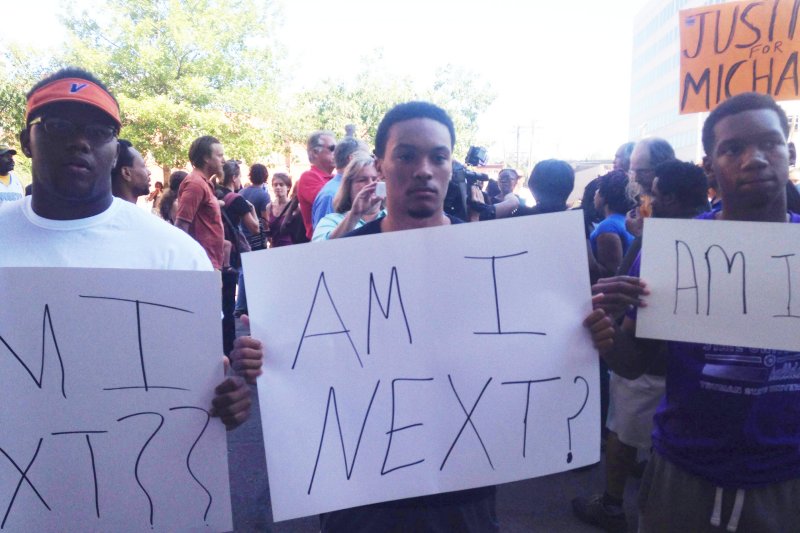FERGUSON, Mo — The people here don’t feel like they’re living in America’s heartland; they feel like they’re living in occupied territory.
The occupied land is small, virtually microscopic in comparison to the St. Louis metropolitan area. The neighborhoods off West Florissant Avenue, including the apartment complex where Michael Brown lived before he was gunned down by a policeman Saturday night, are where most of the city’s black population reside. Patrolling it is Ferguson’s police department of 55 officers, 52 of them white.
“It’s like the elephant in the room,” said Yusra, 45, of East St. Louis. “We are being occupied.”
“They say it’s the death of three men that started a chain reaction of death and destruction in Gaza,” she continued. “Will we as a people rise up like the people of Gaza? Will our community be bombed like last night with tear gas? That was a terrorist attack.”
On Monday, police clashed with protesters who raised their hands in the air and yelled “Don’t shoot!” The gesture has become a rallying cry for Ferguson’s black youth: it’s in reference to the assertion that Brown was on his knees, already shot twice and raising his hands in the air in a symbol of surrender, when the still unnamed officer killed the teen.
 Justin Glawe
Justin GlawePosing for a picture with a groups of friends, a line of riot ready police in the background, Miller Gardner held his hands in the air.
Initially reluctant to give his name due to his impending deployment for the Air Force, Gardner defied any negative repercussions that may come with him speaking out.
“It’s messed up they’re suited for war against civilians,” he said. “I’m not on that side and I’m in the military. They need to come on this side of the line.”
In a McDonald’s not far from Monday night’s protest zone, journalists gathered to sip drinks and use free WiFi Tuesday evening. As the national news broadcasts began, three young men sat down to eat, talking with a woman seated nearby. The topic of conversation is the only thing worth discussing here: Mike Brown, the cop who killed him, and the state of occupation.
“That’s the biggest problem of them all,” said Cory Black, one of the men inside McDonald’s. “We don’t even know who all these officers are who are patrolling our streets.”
Forget all the officers, most people here just want to know the identity of the one who took Brown down, setting off Sunday’s looting, Monday’s clashes, and a national scandal by Tuesday that even saw President Obama weigh in.
Black wore a hat with his surname, the A formed by a depiction of the African continent. With him were Tyrone McDonald, dressed in fatigues and hiking boots, and Robert Henry, his hat bearing a blacked out American flag, hanging upside down. Their militarized garb reflected the atmosphere: West Florissant is a war zone.
“They just started saying to get out of the street or they were going to start shooting,” McDonald said of Monday’s protests. “That’s exactly what they did.”
For the third day protesters and residents made their voices heard. At a morning protest in front of a police-barricaded St. Louis County Attorney’s Office. On the steps of the old courthouse in the shadow of the arch where Al Sharpton addressed a media horde. And finally, fittingly, at the QuikTime gas station, destroyed by Sunday night’s looting. The “QT” as its known is the heart of occupied territory. Yusra sat quietly there holding a sign.
“Mike Brown Is It Going Down Like Gaza?”















